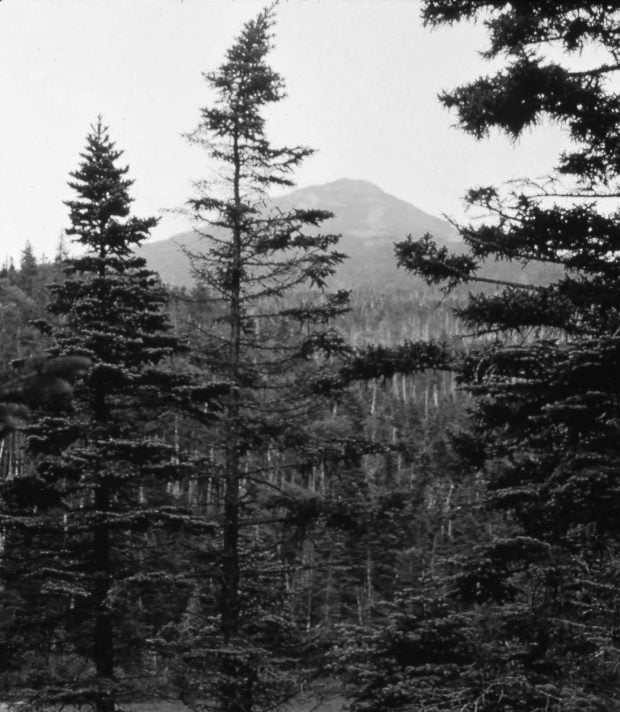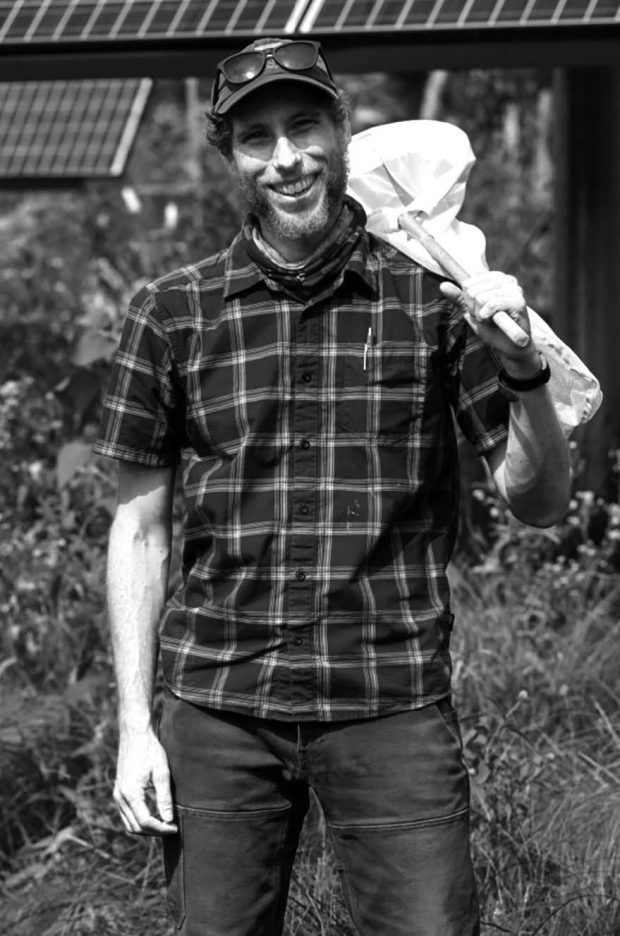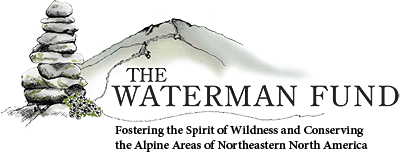2021 Essay Contest Winner
Splitting Clouds at the Edge of the World
How had I never noticed it before?
by Jason Mazurowski

At the kitchen window I leaned and contorted, peering out over the rooftops of Burlington’s Old North End, hoping to catch another glimpse of that ancient tower of anorthosite. Scanning the skyline through a sea of naked branches, gutters, chimneys, and box elder buds, I pieced together the mountaintops, one by one, like a far-off jigsaw puzzle. I could make out the Dix Range, Rocky Peak, and Giant Mountain down to the south—right there above the compost pile—and Whiteface way up north, just to the left of the neighbor’s garage. Then finally, somewhere in the middle of it all, suspended in the crook of a red maple branch: the cloudsplitter itself.*
Though less distinct than its counterparts to the east—Mansfield, Washington, and Katahdin—and more subdued than the jagged, glacier-strewn peaks way out West, Mount Marcy’s summit has an alluring quality in its peculiar ability to remain hidden, so often obscured by a veil of clouds and buttressed by lesser peaks and ridges. But it will catch you off guard from time to time. While clambering over a ridgetop or rounding a bend in the road, you’ll look up to see that snow-covered dome peeking out above evergreen spires.
I’d lived in that apartment for nearly two years. How hadn’t I noticed before? How had an icon of wilderness, on display right outside my window, escaped my gaze for so long? Until recently, my time spent in this kitchen had been somewhat fleeting: hastily assembling a breakfast burrito before rushing off to teach or chopping garlic in the evenings with the blinds pulled down. But by the spring of 2020, it was my window to the world.
Just weeks before, on the other side of the planet, a bundle of nucleotides bound by protein that had been bouncing around inside of a bat or a pangolin or perhaps myriad other mammalian hosts embarked on a transcontinental journey. It mutated and replicated through marketplaces, cruise ships, and concert halls, defying international borders, and toppling global economies before eventually finding its way into my lungs. A feat of biology in its own right.
But I was young, healthy, and content to stay put in the waning days of winter. Besides, there were no classes to be taught, no meetings to rush off to, and no bars to rest an elbow on. The days were short, the streets were empty, and the trails clogged with ice and mud. With daily obligations on hold, my mornings now consisted of hours of observation and reflection. Suddenly I had time for a second or third cup of coffee while watching the neighborhood wildlife begin to stir. I’d check in from time to time with the robins as they built their nest under the eaves. I’d cheer on the bumblebee queens as they scanned the woodpile for a suitable spot to start a colony, and I kept my eyes and ears alert for the first signs of warblers.

Jason Mazurowski in August 2020 surveying bees. - Josh Brown
As weeks passed by, long-dormant buds began to break, and red maple flowers encroached on my view of the mountain. Beneath my feet, starches and sugars—stockpiled sunbeams of bygone days—were drawn from the roots and back to the treetops, driven by the freeze and thaw of winter’s final gasp. Soon, my view would be obscured altogether, and the world would be green again.
In the hours spent tethered to that kitchen, with the human world in suspended animation, I toiled away like a mad scientist: experimenting and fermenting, wielding the principles of ecology and microbiology at my fingertips. Mason jars of sourdough starter, beer, kraut, kimchi, pickled ramps, and fiddleheads spilled out across the countertops. When all that wasn’t enough, I brought the experiments into the yard. I collected as many seeds as I could from pockets of urban wilds, tossing milkweed pods onto bare patches of soil, and punching willow twigs into the ground. I built bumblebee houses and mason bee boxes and hammered mushroom spawn into fresh-cut logs in a crazed frenzy to rewild my corner of the world.
By May, that familiar hum of insects had returned. Out the window, I watched the microbial wonders of the compost bin; the botanical miracles of the garden; and the bees, wasps, and caterpillars going about their business, restarting nature’s economy. I learned the routines of the opossums, raccoons, jays, and the rest of my regular visitors. All along, I found comfort in knowing that out there above it all, beyond the canopy, there stood a wild, geological wonder watching over my rogue ecology.
The heat came on strong, the snow melted fast, and our country had started to buckle under the stress of it all. Maybe it was the humidity, or the helplessness, or all those hours of impromptu reflection, but by the time summer arrived in earnest, everyone was grappling with demons against a backdrop of political chaos. Forays out the front door became more intentional by necessity, and what were once instinctual, ad hoc trips into the backcountry now required greater thought and planning.
My favorite haunts had been discovered by a whole new cohort of adventurers escaping the home office to exercise their newfound freedom (as they should). So, I shirked those beloved, crowded trails and lit out for more remote, overgrown tangles. I scrambled and bushwhacked through bogs and across red pine ridges, and I plunged into the loneliest swimming holes I could find. Yet still, every night and every morning the backyard beckoned from the window, the hum of katydids and crickets holding my attention and connecting me to the natural world.
One August evening, a cool breeze ushered in a welcome reprieve from the heat of the Champlain Valley, and I thought I’d go out and have a fire. A clap of thunder rang out in the distance, and a few raindrops fell on my neck. When I looked up, I noticed that the sky had turned turquoise. The wind whipped up, and as hail started to fall, I ran inside to take cover. While racing to shut the windows, my phone started buzzing and blaring with warnings of imminent weather. When the power cut out, I could hear branches cracking and slapping against the rooftop. I yelled to my partner to run to the basement. On our sprint down the stairs, the last thing I saw was a red maple snapping in half, toppling two other trees like dominoes. It bounced off of the garage and rolled across the garden before coming to rest on the firepit.
The squall lasted only minutes, but it ripped up trees all over town. As the clouds cleared, I peered out the window to survey the destruction. Our chainlink fence had been crushed, but I could see no other structural damage. The storm had blown in from the north, bringing a crispness to the air for the first time in months. As I watched the squirrels inspect the trees, puzzled by their new orientation, something caught my eye way off in the sunset. Through a gap in the mangled branches, and in between the leaves already tinged with autumn red, I saw the summit of Marcy—exactly where I expected.
Upon seeing the mountain again, out there across the lake, I had that same feeling in my gut that I just can’t shake when glimpsing the alpine summits of the East—like looking back in time at our glacial past, transported to the tundra of 10,000 years ago. Maybe that’s how an astronomer feels looking up at the Milky Way, gazing out at our galaxy’s history written in light and radio waves as they make their way across the universe. But there is one crucial difference in the context of mountains. We’re not restricted to merely admiring from a distance; we can go there. We can visit that scoured landscape where the wind howls and the ravens croak and cartwheel. If only temporarily, we can exist in that world where the air smells like balsam fir and Labrador tea, and we can stand upon rock more than a billion years old—ancient beyond ancient—primordial, metamorphosed magma, thrust into the sky, splitting the clouds.
By the time the sun came up the next morning I was already on a ferry, Adirondack-bound, cutting through the swirling fog of autumn’s first chill on the lake. By noon, I had left the hemlocks and hardwoods far below, cruising through the spruces with a grin on my face that must’ve stretched from ear to ear. As I cleared the krummholz I emerged into an eerie calm, and I realized I’d achieved something unthinkable. Traveling fast and light with an early start, a mission on my mind, and a well-timed weekday outing, I had somehow been granted solitude on the summit of Marcy.
I sat there alone, in disbelief, cross-legged and unmasked. Out across the lake I could see the Green Mountains and all of my favorite ridges and hollows. I looked down at Burlington, tucked inconspicuously into the bay. Somewhere out there was my drafty old apartment, the toppled trees, the haphazardly planted garden, and the tiny kitchen with the broken stove where we had been holed up for the last six months, and I was grateful for all of it.
Looking out at the rest of the world, everything seemed calm, clear, and pristine despite incomprehensible suffering in every direction. From up here on my privileged perch, I was blind to all of it. Suddenly, my ignorance had been laid bare, and my initial delight at the absence of others gradually turned into loneliness. In the stillness of that place, juxtaposed against the chaos of the world, I started to sob.
I cried for my family and for my friends, not knowing when I’d see them again. For everyone out there with more courage than me being beaten and tear-gassed in the streets. For the thousands of people hooked up to ventilators, alone and scared. For anyone who had been choked out by floods and wildfires, bearing the brunt of our imminent ecological catastrophes.
My gaze shifted to the summit plaque, the only human object in sight, and it suddenly seemed so out of place. Even here, in one of the wildest places imaginable, evidence of suffering had been right there in front of me. I thought about the people who stared out at these mountains long before any of us, and perhaps for the first time I didn’t attempt to slip their history of heartbreak conveniently to the back of my mind, but instead I leaned into the discomfort, trying to imagine it. How could I possibly know what it felt like to see an entire world ripped away? To have the names of the lakes and mountains replaced, and appropriated only where convenient? I could never know; I could never truly understand. The best I could do was to try, and to finally admit my own ignorance.
Nature crashes through barriers. Falling trees have no respect for property lines, and viruses won’t bend to ideology, but every disaster eventually gives way to clarity, if only in hindsight. In ecology, we refer to these times of tumult as stochastic events. In a forest, the fastest growth, the greatest diversity, and the most novel innovations occur immediately following a disturbance. In the wake of windthrow or wildfire, there’s a blank canvas for a whole new forest.
So where do we go from here? What will become of this seemingly endless, global stochasticity? Most will view 2020 as a year of loss—rightly so—but next comes regeneration, and maybe new growth will fill in the gaps in ways we could never imagine. There’s potential for a young forest to emerge, full of diversity, growth, and innovation. If not for the lockdowns of early spring, or the violent storm I witnessed in August, I might never have been captivated by the intricate relationships around me. I may never have discovered all those opalescent swimming holes, and those patches of endless blueberries. I may never have climbed this beckoning mountain to inadvertently confront my own privilege. I may never have noticed the mountain out the window at all. But why does any of that matter?
I used to quantify wildness as a function of remoteness, measured in miles from the nearest road or trailhead. But the laws of nature don’t stop at the edge of a wilderness boundary. They apply to our farms and towns and cities whether we want them to or not. I cringe whenever I hear that overused adage of the modern naturalist, urging us to “discover what’s in our own backyard.” Perhaps a better, more accurate statement: Embrace the wildness that spills out onto your doorstep.
Still, there’s no substitute for that rarefied air of a lonely ridgetop, and it’s hard to imagine two environments more dissimilar than an urban backyard and a wild, alpine summit. But somehow seeing them together that spring, framed by the same window, made it all seem so continuous, uninterrupted, and unbroken. For most of 2020, my world had been constrained by four walls and that chain-link fence, but now wildness was within reach, everpresent, as if it extended from my window all the way to the highest, wildest peaks of the Northeast, to the heart of wilderness itself—out there at the edge of the world.
Jason Mazurowski is an ecologist, naturalist, and adjunct instructor at the University of Vermont. He earned a master of science degree from the university’s Field Naturalist Program, and he is a former Appalachian Mountain Club hut crew member. He studies Vermont’s native bees and teaches courses in field ecology and pollinator conservation.
Editor’s note: Since 2008, Appalachia and the Waterman Fund have partnered to sponsor an annual essay contest for emerging writers. The fund provides generous prize money and works with the journal to choose winners. In 2017, winning and notable essays from this contest appeared in New Wilderness Voices (University Press of New England). For details about how to enter next year’s contest, see watermanfund.org.
